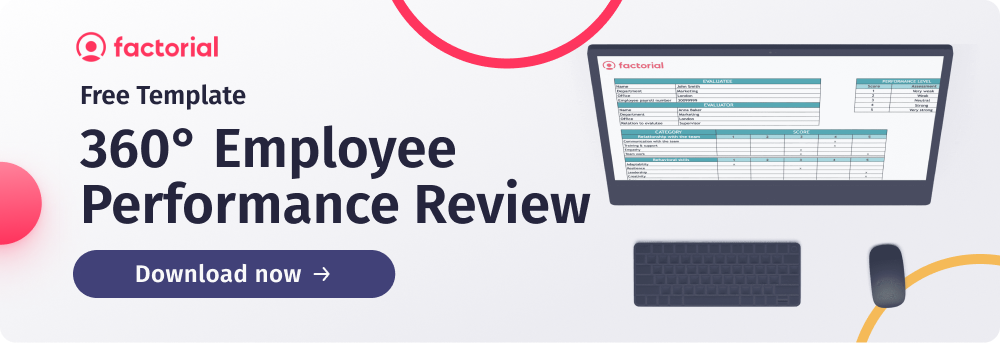Employees are the cornerstone of every company. Managing and directing employees is a key factor in determining the success or failure of the business. For that reason, every manager understands the importance of measuring their employees’ performance and making sure that they are performing in accordance with the pre-set standards. With this in mind, managers apply performance appraisal techniques in order to examine their employees’ capabilities.
Performance appraisal is the systematic evaluation and review of employees’ performance. It uses objective methods to measure their total contributions to achieving the organisation’s goals. The results are then compared to pre-set expectations and goals. In this article, we will be examining the following:
✅ HR Software to Manage Performance Reviews
What is a Performance Appraisal?
Performance appraisal is the formal process when an individual employee’s performance in their role is evaluated over a specific period. It usually involves assessing what the individual has achieved, their strengths and areas for improvement and their overall contribution to the company. It also often includes a discussion about future objectives and development opportunities.
A performance appraisal can also be known as a performance review, employee evaluation or performance assessment.
For most companies, high-quality work from motivated and productive employees is key to meeting their objectives. However, it’s rare to have employees who meet all the requirements of their role to a consistently high standard without ever needing any feedback. Even the strongest performing employees can develop through constructive support, and regular discussions about their role help the individual and organisation thrive by providing space to celebrate success and talk about challenges and potential changes.
An efficient and responsive performance appraisal system can significantly impact a company’s success. In this article, we’ll explore the benefits of evaluating employees and provide examples of different appraisal systems that can drive engagement, performance, and growth.
Performance Appraisal Examples
Creating a 100% reliable and objective performance appraisal method is no easy task. Psychologists and HR experts have been trying to design different techniques to measure and evaluate employees’ performance.
Standard appraisal
The most popular and commonly used method of employee evaluation. Standard evaluation or standard appraisal is based on using a “standard rating scale” where every employee is compared to a set of standards or expectations and then graded based on their performance to a rating usually from 1 to 5. The appraisal is conducted by holding interviews or directly observing employees while performing their tasks.
Self-assessment appraisal
Contrary to the popular opinion that employees overrate themselves, most modern research suggests that employees are very aware of what they can and cannot do. They are more likely to be harsh on themselves in these evaluations so as to not be perceived as arrogant etc.
Moreover, self-assessments give you better insights into how employees perceive their work and their daily tasks. Plus, employees are less likely to dispute the appraisal results with their managers. Self-assessments also play an important role in motivation as they provide employees with a sense of significance and trust.
360-degree appraisals
Many managers prefer conducting 360-degree appraisals involving self-assessment and supervisor and subordinate evaluations. Also known as a 360-degree performance review, this employee assessment is one of the most valid and reliable employee performance measures. In addition, it does not just measure employees’ perceived performance in the organisation but also their relationships with other people.
Additionally, peer evaluations are another example of 360-degree appraisals. Peer evaluation can be defined as the process in which colleagues within the same discipline analyse their peers’ work and provide them with constructive criticism. Peer evaluations are deemed necessary to ensure the work produced is of academic quality.
How to Use the 360-Degree Performance Appraisal Template
We intentionally created the new 360-degree employee assessment template in Google Sheets so that we can keep it up to date! The downloadable file consists of instructions, an example sheet, a template sheet, and a results sheet. The step-by-step instructions and the example sheet will guide you through the employee performance review process. The template sheet can be distributed amongst however many people you’d like including the employee’s managers, colleagues, subordinates, clients, and/or partners. Finally, the results sheet provides you with a place to compile your results and extract your findings.
By using 360-degree employee performance reviews, you’ll better understand each employee in your organisation. It will highlight both their strengths, as well as areas of improvement. The latter can be addressed by organising training, courses, webinars, coaching, etc. Doing so will help your employees reach their potential, increasing their satisfaction with your organisation.
Benefits of a Performance Appraisal
Personal and career development
Performance appraisal measures employees’ performance, allowing them to identify their points of strengths and weaknesses. This helps in employees’ personal growth, as they will try to overcome their weaknesses and enhance their strengths. This will result in improving their performance and gaining new skills and experience.
Organisational planning
Another way to utilise performance appraisals is by examining previous results to understand how the company is currently performing. This can help managers determine future organisational goals and objectives. It can also help assign and reallocate employees to the most suitable positions based on their abilities and skills.
Motivational tools
Performance appraisals positively impact motivation by identifying hard-working and high-performing employees and rewarding them for their efforts. This job recognition gives a sense of appreciation and significance to employees. Similarly, identifying high performers would also allow the company to allocate promotions, bonuses, awards efficiently, and raises to those who truly deserve them.
In addition, performance appraisal is a key feedback and communication tool. Upon collecting performance results, companies would be able to provide a sense of direction to those who need guidance. It will also allow employees to communicate their issues and difficulties in their daily tasks, which would help to improve their motivation.
Training
Companies can use data obtained from appraisals and performance reviews to design training programs that are well-suited for each employee’s needs. This will result in improving employees’ skills and increasing their chances to get promoted in the company. Performance appraisals can also be used to determine the effectiveness of the training by measuring employees’ performance and comparing results before and after implementing the program.
Self Assessment Appraisal Review
You may hear a self-assessment appraisal referred to as a self-appraisal. It occurs when an employee takes the criteria used to judge performance in their role and evaluates their contribution themselves before knowing what their manager thinks.
Encouraging employees to review their own performance as part of the appraisal system can build self-awareness and problem-solving skills, give individuals a sense of agency over their role and encourage employees to think about areas that can be improved or developed within the wider business.
It also plays an important role in helping employees prepare for their performance review meetings. Not only is it useful for individuals to have spent time looking over their contribution, but having self assessment as part of the review process sets the tone for a meeting where different perspectives are shared and respected. This approach can open up a constructive dialogue about expectations, challenges, and personal and company goals.
Some companies encourage employees to fill in and share their self-assessment appraisal before the appraisal meeting, while others use self-assessment as a private opportunity for employees to reflect on their contribution and do not expect the employee to share the written details with their manager.
Self-Assessment Appraisal Example
Self-assessment appraisals can be simple documents. The following is a suggested structure:
Performance
The employee outlines how they believe they performed in the reviewed period, highlighting their achievements.
Strengths
The employee lists what they believe to be their strengths and how they contribute to the role and the company.
Areas for Improvement
The employee indicates areas where they want to improve and potentially include specific ideas to support these improvements, such as training or mentoring.
Professional Development
The employee lists anything they have achieved in the period that contributes to professional development.
Goals
The employee shares personal or professional goals they have identified for the next appraisal period.
Feedback
The employee provides feedback to the manager and company on anything they believe might be helpful for their role in the future.
How to Implement a Performance Appraisal
Giving and receiving feedback can be challenging. It is most important to keep in mind that you are helping someone to learn and develop themselves by providing feedback during the whole performance evaluation and review process.
The most impactful thing you can do is to create an environment where honest and open feedback is integral to the team culture. If you are still worried about delivering negative feedback, bear in mind that many employees are very clear that they want the feedback that leaders often struggle to provide.
The following are a few specific tips which can help ensure you have productive discussions when providing an employee with feedback on their past performance:
1. Prepare
When sharing feedback with employees, it pays off to take some time to think through what you want to say and the best way to say it. You may want to have an agenda and prepared notes to help structure the conversation. If the feedback is particularly tricky or contentious, it can also be useful to sense-check your approach with your HR manager, who can help you ensure you use appropriate language and follow company processes as necessary.
2. Create a Safe Space
If you want a productive and useful conversation that enhances future performance, your employee needs to trust that you will be honest, respectful and supportive. Unless there is a good reason to do it differently (for example, in some difficult cases, you may need to have a third person or HR representative present), all performance discussions and appraisals should be one-on-one in a private space. Clarify at the start how the process will work and any expectations you have.
3. Make it Timely
It doesn’t matter whether it is constructive or positive, don’t wait to deliver feedback. Anything constructive is best received soon after the event to avoid any escalation or issues building up and to allow individuals to learn immediately from their mistakes.
4. Be Specific and Factual
The most effective feedback focuses on the specific problem, not the person, and provides factual information rather than conjecture or unsubstantiated opinion. By bringing attention to a particular issue, it is possible to frame the feedback in the context of a specific goal and why it is important for the employee’s contribution to the team or overall business to get it right. This framing can make it easier for employees to receive constructive feedback and make them less defensive, creating a more effective performance review.
5. Be Positive and Constructive
Researchers have found that the highest-performing teams are those where there is far more praise than criticism, but the critical component is still essential to their success. According to the Harvard Business Review, the average praise-to-criticism ratio of the highest-performing teams was 5.6, which is nearly six positive comments for every negative one.
However, when it comes to performance reviews, we don’t recommend the commonly used approach of starting with praise, following with constructive stuff and finishing with more praise. Not only are many employees already aware of this idea (commonly referred to as a specific type of sandwich), it usually doesn’t work.
Challenges When Implementing a Performance Appraisal
Validity and reliability
Validity is defined as whether the evaluation tool measures what it is supposed to and meant to measure accurately. Reliability is defined as whether the evaluation tool provides consistent results every time. It is impossible to find a 100% valid and reliable evaluation tool. So, there is always a percentage of uncertainty and errors in the appraisal results.
Potential biases
Because it is difficult to develop a 100% valid and reliable tool, potential biases when conducting the appraisal are likely to exist. For instance, although 360-degree assessment is very reliable and useful for the business, supervisors might be too lenient or harsh while evaluating their subordinates. Similarly, employees might over or underrate their supervisors depending on their relationship with them.
Unattainable goals
Setting goals that are impossible to accomplish can lead to general dissatisfaction when they are not met. Consider a manager setting a 100-unit of sales every day even though the current market capacity only allows for 50 units. No matter how hard employees try to meet this goal, they will not succeed. Though it is not their fault, employees will be considered underperforming due to their inability to attain the goal.






